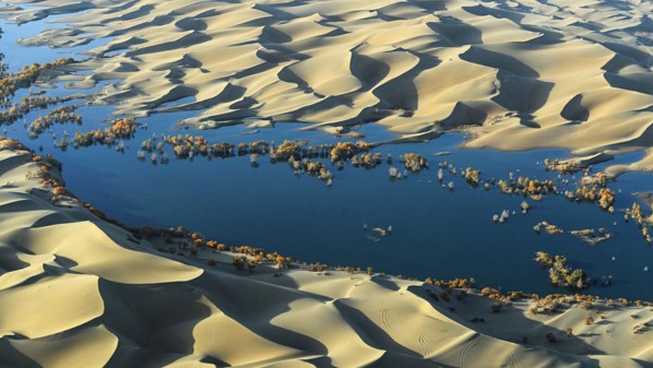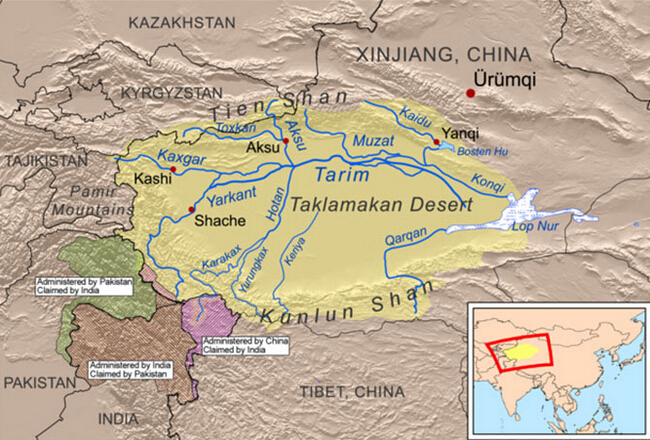Carbon Tomb Buried Deep under Chinese Desert
2015-08-10

Runoff from irrigated fields and river beds in China’s Taklamakan desert has pumped nearly 20 billion tons of carbon into underground aquifers there. (Image by LI Yan)
China’s Taklamakan desert—a windswept landscape of sand dunes and dried-out riverbeds—has been called the place where “you can go in, but you can’t come out.” That saying might apply to more than just people. Carbon—as much as 20 billion tons—has found its final resting place in aquifers hundreds of meters beneath the shifting sands there, according to a new study. The findings may extend to other deserts around the world, shedding light on a long-standing mystery about where the world’s carbon goes after we burn it.
For the last 150 years, humans have been burning fossil fuels and spewing carbon into the atmosphere—11 billion tons per year, at last count. Half of that stays in the atmosphere as carbon dioxide, where it traps heat and contributes to global warming. The other half accumulates in the oceans and on land. Although climate scientists can measure the carbon stored in the oceans, air, and forests, they can’t account for it all. In fact, billions of tons of carbon go missing every year—up to 2 billion in 2014—and researchers have been searching for it for decades.
The new study, in
That something is a

The Tarim Basin lies at the heart of Asia, where meltwater from glaciers in the surrounding mountains empties into an oasis-dotted depression. (Kmusser/Creative Commons/Wikimedia)
By the time the water reaches the aquifers, it contains so much carbon that it would fizz like a soda if it surfaced, says lead author and desert biogeochemist Li Yan of the Xinjiang Institute of Ecology and Geography in China. And because the brine is unsuitable for drinking or irrigation, no one has bothered to pump it back up. “It is basically a one-way trip,” Li says.
He and his colleagues estimate that if similar systems exist in the world’s other major desert basins—the Northwestern Sahara Basin, Australia’s Murray Basin, and the Great Basin in the United States—they could be storing up to 1000 billion tons of carbon, more than all the living plants on earth. Annually, that means saline desert aquifers would be taking in and storing about 4% of the missing carbon.
To reach that number, admittedly an “upper bound,” Li and his colleagues collected more than 600 samples from glaciers, fields, and aquifers in the Tarim Basin, a vast depression that encompasses the Taklamakan. They tapped into desert wells up to 300 meters deep and measured the carbon content of their samples. They then calculated age and accumulation rates using carbon 14 dating.
They discovered that the amount of carbon stored in the basin has accelerated dramatically, from only 2 grams per square meter 8000 years ago to more than 21 grams per square meter for the last 1000 years. The biggest jump came between 2000 and 5000 years ago, when farming activity increased. This suggests that the region’s carbon storage increased along with the expansion of human agricultural activity, Li says. He says that it may even explain a small part of the mystery of the missing carbon.
But the new sink seems like an unlikely candidate to square up the budget, says William Schlesinger, a biochemist at the Cary Institute of Ecosystem Studies in Millbrook, New York, who was not involved in the study. “We ought to recognize it for an interesting piece of work, but it’s not going to set the carbon cycling community on its head,” he says.
To solve the mystery, any new sink would have to show a dramatic increase in storage capacity over the last 150 years, Schlesinger says. Prior to that, carbon production and storage were balanced, without the massive deficit seen today. “You can’t turn around and say, we’ve measured a new sink that accounts for the uptake of fossil fuel carbon dioxide from the industrial revolution, because essentially [this sink] was there before.” Li contends that carbon storage in the basin has continued to grow over the past 150 years, but his data isn’t detailed enough to prove it.
Regardless, Evans says the study shows the remarkable carbon storage capacity of deserts. He says it may be worth testing other desert basins. “It opens up another mechanism that we perhaps haven’t thought about,” he says. “And I think it’s up to us to test it now.” (Science AAAS)
Contact
LI Yan
Xinjiang Institute of Ecology and Geography, Chinese Academy of Sciences
E-mail: liyan@ms.xjb.ac.cn



